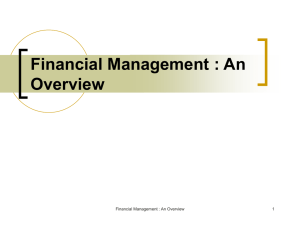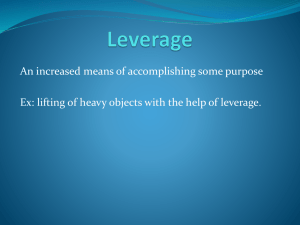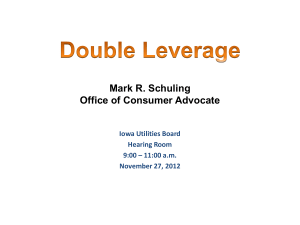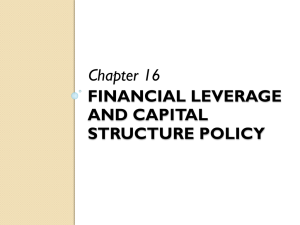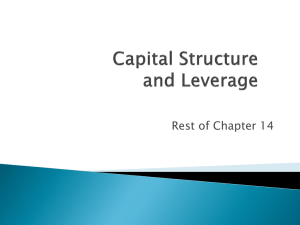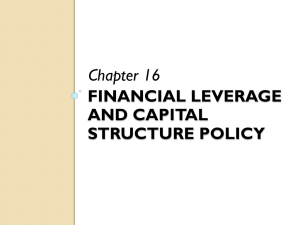File
advertisement
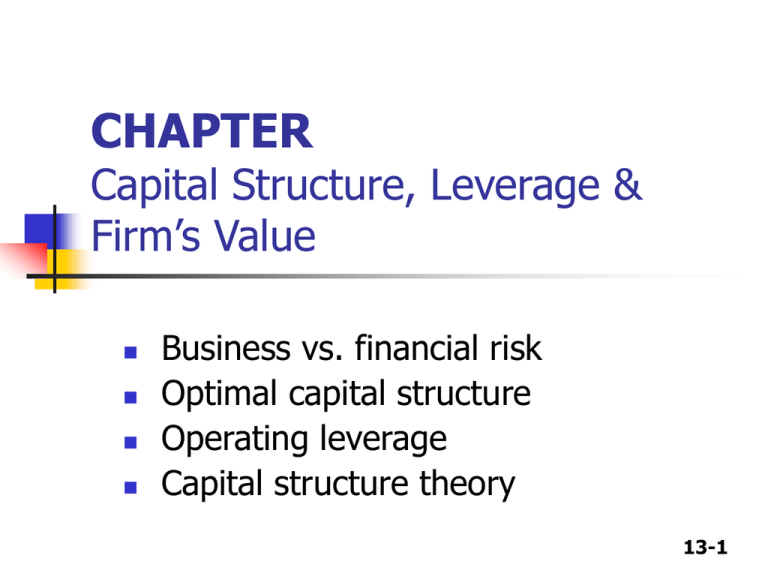
CHAPTER Capital Structure, Leverage & Firm’s Value Business vs. financial risk Optimal capital structure Operating leverage Capital structure theory 13-1 Capital Structure, Leverage & Firm’s Value Capital Structure and Leverage 13-2 What is Leverage A firm can make use of different sources of financing whose cost are different. These cost may be classified into those which carry a fixed rate of return and those on which the return Vary. The employment of an asset or source of funds for which the firm has to pay a fixed cost or fixed return may be termed as a Leverage. 13-3 Types of Leverage There are two types of Leverage Operating Leverage: the leverage associated with investment (asset acquisition) activities is referred to as operating leverage. Financial Leverage: the leverage associated with financing activities is referred to as financial leverage. 13-4 What is operating leverage, and how does it affect a firm’s business risk? Operating leverage is the use of fixed costs rather than variable costs. If most costs are fixed, hence do not decline when demand falls, then the firm has high operating leverage. 13-5 Effect of operating leverage More operating leverage leads to more business risk, for then a small sales decline causes a big profit decline. Rev. Rev. $ TC $ } Profit TC FC FC QBE Sales QBE Sales What happens if variable costs change? 13-6 Using operating leverage Low operating leverage Probability High operating leverage EBITL EBITH Typical situation: Can use operating leverage to get higher E(EBIT), but risk also increases. 13-7 What is financial leverage? Financial risk? Financial leverage is the use of debt and preferred stock. Financial risk is the additional risk concentrated on common stockholders as a result of financial leverage. 13-8 Business risk vs. Financial risk Business risk depends on business factors such as competition, product liability, and operating leverage. Financial risk depends only on the types of securities issued. More debt, more financial risk. Concentrates business risk on stockholders. 13-9 An example: Illustrating effects of financial leverage Two firms with the same operating leverage, business risk, and probability distribution of EBIT. Only differ with respect to their use of debt (capital structure). Firm U No debt $20,000 in assets 40% tax rate Firm L $10,000 of 12% debt $20,000 in assets 40% tax rate 13-10 Firm U: Un-leveraged Prob. EBIT Interest EBT Taxes (40%) NI Economy Bad Avg. 0.25 0.50 $2,000 $3,000 0 0 $2,000 $3,000 800 1,200 $1,200 $1,800 Good 0.25 $4,000 0 $4,000 1,600 $2,400 13-11 Firm L: Leveraged Prob.* EBIT* Interest EBT Taxes (40%) NI Economy Bad Avg. 0.25 0.50 $2,000 $3,000 1,200 1,200 $ 800 $1,800 320 720 $ 480 $1,080 Good 0.25 $4,000 1,200 $2,800 1,120 $1,680 *Same as for Firm U. 13-12 Ratio comparison between leveraged and un-leveraged firms FIRM U BEP ROE TIE FIRM L BEP ROE TIE Bad Avg Good 10.0% 6.0% ∞ 15.0% 9.0% ∞ 20.0% 12.0% ∞ Bad Avg Good 10.0% 4.8% 1.67x 15.0% 10.8% 2.50x 20.0% 16.8% 3.30x 13-13 Risk and return for leveraged and un-leveraged firms Expected Values: E(BEP) E(ROE) E(TIE) Firm U 15.0% 9.0% ∞ Firm L 15.0% 10.8% 2.5x Firm U 2.12% 0.24 Firm L 4.24% 0.39 Risk Measures: σROE CVROE 13-14 The effect of leverage on profitability and debt coverage For leverage to raise expected ROE, must have BEP > kd. Why? If kd > BEP, then the interest expense will be higher than the operating income produced by debt-financed assets, so leverage will depress income. As debt increases, TIE decreases because EBIT is unaffected by debt, and interest expense increases (Int Exp = kdD). 13-15 Conclusions Basic earning power (BEP) is unaffected by financial leverage. L has higher expected ROE because BEP > kd. L has much wider ROE (and EPS) swings because of fixed interest charges. Its higher expected return is accompanied by higher risk. 13-16 Capital Structure, Leverage & Firm’s Value Capital Structure & Firm’s Value 13-17 Relationship between capital structure & cost of capital Assumptions There is no income tax, corporate or personal. 100% dividend payout ratio is assumed The operating income is not expected to grow or decline over time. A firm can change its capital structure almost instantaneously without incurring transaction cost. 13-18 Net Income Approach According to this approach, the cost of debt rD and the cost of equity rE remain unchanged when D/E varies. The constancy of rD and rE with respect to D/E means That ra the average cost of capital decline as D/E increases. D rA = rD [ D+E E ]+ rE [ ] D+E Where, rD = Cost of Debt capital D = Market value of debt E = Market value of equity 13-19 Net Income Approach Problem: there are 2 firms A & B similar in all aspects except in the capital structure. Financial data for these firms are shown bellow, Firm A Firm B O Operating income 10,000 10,000 I Interest on debts 0 3,000 rE Cost of equity capital 10% 10% rD Cost of Debt capital 6% 6% D Market value of debt 0 50,000 E Market value of equity 100,000 70,000 Required: Calculate the average cost of capital for firm A & B (a) For Firm A 0 100,000 rA = 6%[ ] + 10% [ 100,000 100,000 (a) For Firm B 50,000 70000 rA = 6%[ ] + 10% [ 120,000 100,000 ] = 10% ] = 8.5% 13-20 Net Operating Income Approach According to this approach, the over all capitalization rate and the cost of debt remain constant for all degree of leverage. The cost of equity can be expressed as, rE=rA + (rA – rD) (D/E) Problem: Firm A Firm B O Net Operating income 10,000 10,000 rA Overall Capitalization Rate 0.15 0.15 V Total Market Value 66,667 66,667 I Interest on debts 1000 3,000 rD Debt capitalization rate 0.10 0.10 D Market value of debt 10,000 30,000 E Market value of equity 56,667 36,667 D/E Financial Leverage 0.176 0.818 Ans: The Equity Capitalization rates of Firms A & B can be calculated as follows, Firm A : rE= 15 + (15 – 10) 0.176 = 15.9% Firm B : rE= 15 + (15 – 10) 0.818 = 19.1% 13-21 Traditional Approach The main proposition of the traditional approach are, The cost of debt capital, rD, remain more or less constant up to a certain degree of leverage but rises thereafter at an increasing rate. The cost of equity capital, rE, remain more or less constant or rises only gradually up to a certain degree of leverage and rises sharply thereafter. The average cost of capital, rA, as a consequence of the above behavior of rD & rE, (1) decreases up to a certain point (2) remain more or less unchanged for moderate increase in leverage thereafter; and (3) rises beyond a certain point. 13-22 Modigliani & Miller Position So far, we have examined three conflicting views on capital structure. Which one is correct? To answer this question we need a formal theory of capital structure. Such a theory was first proposed by Franco Modigliani and Merton Miler in their classic contribution on capital structure which is regarded by many as the most important paper in modern Finance. Both of them subsequently became Nobel Laureates in Economics. Assumptions of Modigliani & Miller Position Perfect capital Market: Information is freely available and there is no problem of asymmetric information, transaction are costless, there are no bankruptcy costs, securities are infinitely divisible. Rational Investors & Managers: Investors rationally choose a combination of risk and return that is most advantageous for them. Managers act in the interest of shareholders. Homogeneous Expectation: Investors hold identical expectations about future operating earnings. Equivalent Risk Classes: Firms can be grouped into “Equivalent Risk Classes” on the basis of their business risk. Absence of taxes: There is no Tax. 13-23 Modigliani & Miller Position Proposition 1 MM’s First proposition is, “The value of a firm is equal to its expected operating income divided by the discount rate appropriate to its risk class. It is independent of its capital structure”. In symbol: V = D+E = O / r Where, V= Market Value of the Firm D = Market Value of the Debt E = Market Value of the Equity O = Expected operating income r = Discount rate applicable to the risk class to which the firm belongs. Proposition 2 MM’s First proposition is, “The expected return on equity is equal to the expected return on assets, plus a Premium. The premium is equal to the debt-equity ratio times the differences between the expected return on assets and the expected return on Debt.” In symbol: rE = rA +(rA – rD) (D/E) Where, Expected operating income Expected return on assets = rA = Market value of all securities 13-24 Problem The following information is available for XYZ metals. Net operating income Tk. 40 Million Interest on Debts Tk. 10 Million Cost of Equity 18% Cost of Debts 12% Required: use the NI Method & assume there are no tax (a) What is the average cost of capital of XYZ metals? (b) What happen to the average cost of capital of XYZ metals, if it employs Tk. 100 million of debt to finance a project which earns an operating income of Tk. 20 Million? Solution: The market value of Debt = (Tk. 10 million / 0.12) = Tk. 83.33 million The market value of Equity = (Tk. 30 million / 0.18) = Tk. 166.67 million Hence, the average cost of capital for XYZ metals is: 83.33 166.67 12 x + 18 x 250.00 250.00 = 16% 13-25 Problem If XYZ metals employs Tk. 100 million of debt to finance a project which earns an Operating income of Tk. 20 million, the following financial picture emerge, Net operating income Interest on Debts Equity earnings Market value of equity Market value of Debt Market value of the Firm Tk. Tk. Tk. Tk. Tk. Tk. 60 Million 22 Million 38 million 211.11 million 183.33 million 394.44 million 183.33 12 x 394.44 = 15.21% 211.11 + 18 x 394.44 13-26 Problem The management of “P&G” subscribes to the NOI approach and believes that its cost of debt and overall cost of capital will remain 9% and 12% respectively. If the Debt/Equity ratio is 0.8, what is the cost of equity? Solution: As per the NOI approach, the cost of equity is, rE = rA +(rA – rD) (D/E) = 12+(12-9)0.8 = 14.4%. 13-27 Problem Consider the following information for Optima Limited. Net operating income Tk. 210 Million Corporate Tax rate 30% Market(as well as book) value Tk. 300 million Capitalization rate applicable to a debt free firm in the risk class to Which Optima belongs 16% Required: What will be the value of Optima Limited according to Modigliani & Miller Approach? Solution: According to Modigliani & Miller Approach, (1-tc) V=0 + tcB r = 210 (1-0.3)/0.16+(0.3x300) = 918.75+90 = 1008.75 million. 13-28 Capital Structure Decision 13-29 Capital Structure Decision How can the optimal capital structure in practice? There does not seem to be any single method or technique that enable a firm to to ‘hit’ the optima capital structure. As you explore capital structure Decision, you will realize that it is not amenable to a neat, structured solution. A variety of analysis are done in practice to get a handle over the capital structure decision. One analysis looks at how alternative capital structure influence the earnings per share. A second analysis assesses the impact of alternative capital structure on return on equity. A third analysis relies on certain leverage ratios. A fourth analysis determines the level of debt that can be serviced by the expected cash flows of the firm. A fifth analysis relies on what comparable firms are doing. Admittedly, each of these analysis is incomplete and provides a partial answer to the question” what capital structure maximize the value of the firm?” In practice, Firms commonly use one or more of these kinds of analysis along with qualitative guidelines to address the capital structure issue. 13-30 EBIT-EPS Analysis In our search for optimal capital structure, we need,inter alia, to understand how sensitive is earning per share (EPS) to changes in earning before interest & tax (EBIT) under different financing alternatives. Basic Relationship (EBIT – i) (1 – t) EPS = n Where, i = interest t = tax rate n = number of equity share When Preference dividend (Dp) is payable, the relationship becomes, (EBIT – i) (1 – t) - Dp EPS = n 13-31 EBIT-EPS Analysis Problem: Existing Capital Structure : 1 million equity shares of Tk. 10 each. Tax rate : 50%. Falcon Limited plans to raise additional capital of Tk. 10 million for financing an expansion projects. In this context,it is evaluating two alternatives two alternative financial plans: (1) issue of Equity shares ( 1 million Equity shares @ Tk. 10 each.) and (2) issue of debentures carrying 14% interest. Required: What will be the EPS under the two alternative financial plans for two levels of EBIT, say Tk. 4 million & 2 million? 13-32 EBIT-EPS Analysis Equity Financing EBIT 2000000 EBIT 4000000 Interest Debt Financing EBIT 2000000 EBIT 4000000 1,400,000 1,400,000 Profit Before Taxes 2,000,000 4000000 6000000 2600000 Taxes 1000000 2000000 300000 1300000 Profit after Taxes 1000000 2000000 300000 1300000 No. of Equity Shares 2000000 2000000 1000000 1000000 EPS 0.50 1.00 0.30 1.30 13-33 ROI-ROE Analysis We may look at the relationship between the Return on Investment (ROI) & Return on Equity (ROE) for different level of financial leverage. The influence of ROI & Financial Leverage on ROE is mathematically as follows, ROI = (EBIT/Total Assets) ROE = [ROI+(ROI-r)D/E](1-t) Where, r = Cost of Debt D/E = Debt-Equity Ratio t = Tax rate 13-34 ROI-ROE Analysis Problem Korex Limited, requires an investment outlay of Tk. 100 million, is Considering two capital structures: Capital Structure “A” Capital Structure “B” Equity 100 Million 50 Million Debt 0 Million 50 Million Average cost of capital is fixed at 12%, the ROI(EBIT/Total Assets) may vary widely. The Tax rate is 50%. 13-35 ROI-ROE Analysis Capital Structure “A” Capital Structure “B” 5% 10% 15% 20% 25% 5% 10% 15% 20% 25% 5 10 15 20 25 5 10 15 20 25 Interest 0 0 0 0 0 5 5 5 5 5 Profit before Tax 5 10 15 20 25 0 5 10 15 20 Tax 2.5 5 Profit after Tax 7.5 10 12.5 0 2.5 5 7.5 10 2.5 5 7.5 10 12.5 0 2.5 5 7.5 10 RIO EBIT Return on Equity 2.5% 5% 7.5% 10% 12.5% 13-36 0% 5% 10% 15% 20% ROI-ROE Analysis ROE B A 20 15 10 5 5 10 15 20 25 30 ROI 13-37 ROI-ROE Analysis Looking at the relationship between ROI & ROE we find that, The ROE under capital structure A is higher than the ROE under capital structure B, when ROI is less than the cost of Debt. The ROE under two capital structures is the same when ROI is equal to the cost of Debt. Hence the indifference/breakeven value of ROI is equal to the cost of debt. The ROE under capital structure B is higher than the ROE under Capital structure A, when ROI is more than the cost of Debt. Mathematical Relationship The influence of ROI and Financial Leverage on ROE is mathematically as follows, ROI = (EBIT/Total Assets) ROE = [ROI+(ROI-r)D/E](1-t) Applying the above equation to Korex Limited, when its D/E ration is 1, we may calculate the value of ROE for two values of ROI, 15% & 20%. 13-38 ROI-ROE Analysis ROI = 15% ROE = [15+(15- 10)1](0.5) = 10.0% ROI = 20% ROE = [20 +(20 - 10)1](0.5) = 15.0% 13-39 Ratio Analysis Traditionally firms have looked at certain ratio to assess whether they have a satisfactory capital structure. The commonly used ratios are: Interest coverage ratio Cash flow coverage ratio Debt service coverage ratio Fixed asset coverage ratio Interest coverage ratio EBIT Interest coverage ratio = interest on debt Suppose EBIT for Vitrex company were Tk. 120 million and the interest burden on all debts were Tk. 20 million. The interest coverage ratio = 120/20 = 6. It means that even if EBIT drops by 83.5%, the earnings of Vitrex cover its interest payment. 13-40 Ratio Analysis Cash flow coverage ratio EBIT+Depreciation+other non-cash charge Cash flow coverage ratio = Loan repayment installment interest on Debt + (1-Tax rate) Consider the following data for Vitrx Limited Depreciation Tk. 20 million EBIT Tk. 120 million Interest on Debt Tk. 20 million Tax rate 50% Loan repayment installment Tk. 20 million 13-41 Ratio Analysis 120 + 20 Cash flow coverage ratio = 20 20 + (1-0.5) = 3.5 Cash flow coverage ratio measure the debt capacity, covers the debt service burden fully and focuses on cash flows. 13-42 Ratio Analysis Debt service coverage ratio Financial Institutions which provide the bulk of loan-term debt finance judge the debt capacity of firm in terms of its debt service coverage ratio. This is defined as, PATi +DEPi +INTi +Li Debt service coverage ratio = INTi +LRIi +Li Where, PAT = Profit after tax for year i DEP = Depreciation for year i INT = Interest on long term loan for year i LRI = Loan repayment installment for year i L = Lease rental for year i N = period of the loan 13-43 Ratio Analysis Year 1 2 3 4 5 6 7 8 9 10 PAT -2.0 10 20 25 30 40 40 50 55 55 DEP 12 10.8 9.72 8.75 7.87 7.09 6.38 5.74 5.17 4.65 INT 17.6 17.6 17.05 14.85 12.65 10.45 8.25 6.05 3.85 1.65 LRI - - 20 20 20 20 20 20 20 20 13-44 Ratio Analysis PATi +DEPi +INTi +Li Debt service coverage ratio = INTi +LRIi +Li DSCR = 521.17/270.00 = 1.93 Normally, financial institutions regard a dent service coverage ratio of 1.50 to 1.75 as satisfactory. If the ratio is significantly less than 1.50 and the project is otherwise Desirable, a term loan of a longer maturity may be provided. If the ratio is significantly more than 1.75, the maturity may be shortened. 13-45 Ratio Analysis Fixed Asset Coverage Ratio Fixed Asset Fixed Asset Coverage Ratio = Term Loan Financial institutions feel comfortable if the fixed asset coverage ratio is at least 1.25 13-46 13-47 13-48 13-49


